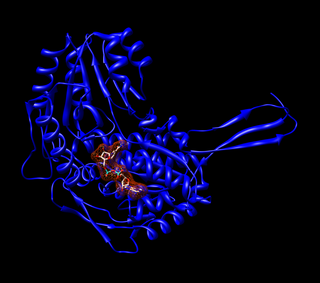Chemically, an aldehyde is a compound containing a functional group with the structure −CHO, consisting of a carbonyl center with the carbon atom also bonded to hydrogen and to any generic alkyl or side chain R group. The functional group itself is known as an aldehyde or formyl group.

In organic chemistry, a carbonyl group is a functional group composed of a carbon atom double-bonded to an oxygen atom: C=O. It is common to several classes of organic compounds, as part of many larger functional groups. A compound containing a carbonyl group is often referred to as a carbonyl compound.

The aldol reaction is a means of forming carbon–carbon bonds in organic chemistry. Discovered independently by the Russian chemist Alexander Borodin in 1869 and by the French chemist Charles-Adolphe Wurtz in 1872, the reaction combines two carbonyl compounds to form a new β-hydroxy carbonyl compound. These products are known as aldols, from the aldehyde + alcohol, a structural motif seen in many of the products. Aldol structural units are found in many important molecules, whether naturally occurring or synthetic. For example, the aldol reaction has been used in the large-scale production of the commodity chemical pentaerythritol and the synthesis of the heart disease drug Lipitor.

An aldol condensation is a condensation reaction in organic chemistry in which an enol or an enolate ion reacts with a carbonyl compound to form a β-hydroxyaldehyde or β-hydroxyketone, followed by dehydration to give a conjugated enone.

A reducing sugar is any sugar that is capable of acting as a reducing agent. In an alkaline solution, a reducing sugar forms some aldehyde or ketone, which allows it to act as a reducing agent, for example in Benedict's reaction. In such a reaction, the sugar becomes a carboxylic acid.
The Cannizzaro reaction, named after its discoverer Stanislao Cannizzaro, is a chemical reaction that involves the base-induced disproportionation of two molecules of a non-enolizable aldehyde to give a primary alcohol and a carboxylic acid.
Fatty alcohols (or long-chain alcohols) are usually high-molecular-weight, straight-chain primary alcohols, but can also range from as few as 4–6 carbons to as many as 22–26, derived from natural fats and oils. The precise chain length varies with the source. Some commercially important fatty alcohols are lauryl, stearyl, and oleyl alcohols. They are colourless oily liquids (for smaller carbon numbers) or waxy solids, although impure samples may appear yellow. Fatty alcohols usually have an even number of carbon atoms and a single alcohol group (–OH) attached to the terminal carbon. Some are unsaturated and some are branched. They are widely used in industry. As with fatty acids, they are often referred to generically by the number of carbon atoms in the molecule, such as "a C12 alcohol", that is an alcohol having 12 carbons, for example dodecanol.
Stearyl alcohol, or 1-octadecanol, is an organic compound classified as a saturated fatty alcohol with the formula CH3(CH2)16CH2OH. It takes the form of white granules or flakes, which are insoluble in water. It has a wide range of uses as an ingredient in lubricants, resins, perfumes, and cosmetics. It is used as an emollient, emulsifier, and thickener in ointments, and is widely used as a hair coating in shampoos and hair conditioners. Stearyl heptanoate, the ester of stearyl alcohol and heptanoic acid (enanthic acid), is found in most cosmetic eyeliners. Stearyl alcohol has also found application as an evaporation suppressing monolayer when applied to the surface of water.

Cetaphil or is a line of skin care products from Galderma Laboratories, including cleansers, bar soap, cream, lotion, and moisturizers. It was developed in 1947, in Texas, by an American pharmacist. Cetaphil products are available worldwide in more than 70 countries, commonly sold at grocery stores and pharmacies throughout the United States, Canada and India. They are also available in pharmacies in Australia, Hong Kong, South Korea, Indonesia, the Philippines, South Africa, Singapore, some European, Latin American and Caribbean countries.

Aldehyde dehydrogenases are a group of enzymes that catalyse the oxidation of aldehydes. They convert aldehydes to carboxylic acids. The oxygen comes from a water molecule. To date, nineteen ALDH genes have been identified within the human genome. These genes participate in a wide variety of biological processes including the detoxification of exogenously and endogenously generated aldehydes.
Cetrimonium chloride, or cetyltrimethylammonium chloride (CTAC), is a topical antiseptic and surfactant. Long-chain quaternary ammonium surfactants, such as cetyltrimethylammonium chloride (CTAC), are generally combined with long-chain fatty alcohols, such as stearyl alcohols, in formulations of hair conditioners and shampoos. The cationic surfactant concentration in conditioners is generally of the order of 1–2% and the alcohol concentrations are usually equal to or greater than those of the cationic surfactants. The ternary system, surfactant/fatty alcohol/water, leads to a lamellar structure forming a percolated network giving rise to a gel.

Cetostearyl alcohol, cetearyl alcohol or cetylstearyl alcohol is a mixture of fatty alcohols, consisting predominantly of cetyl and stearyl alcohols and is classified as a fatty alcohol. It is used as an emulsion stabilizer, opacifying agent, and foam boosting surfactant, as well as an aqueous and nonaqueous viscosity-increasing agent. It imparts an emollient feel to the skin and can be used in water-in-oil emulsions, oil-in-water emulsions, and anhydrous formulations. It is commonly used in hair conditioners and other hair products.

Fatty aldehyde dehydrogenase is an aldehyde dehydrogenase enzyme that in human is encoded in the ALDH3A2 gene on chromosome 17. Aldehyde dehydrogenase enzymes function to remove toxic aldehydes that are generated by the metabolism of alcohol and by lipid peroxidation.

Aldehyde dehydrogenase, mitochondrial is an enzyme that in humans is encoded by the ALDH2 gene located on chromosome 12. This protein belongs to the aldehyde dehydrogenase family of enzymes. Aldehyde dehydrogenase is the second enzyme of the major oxidative pathway of alcohol metabolism. Two major liver isoforms of aldehyde dehydrogenase, cytosolic and mitochondrial, can be distinguished by their electrophoretic mobilities, kinetic properties, and subcellular localizations.

Aldehyde oxidase (AO) is a metabolizing enzyme, located in the cytosolic compartment of tissues in many organisms. AO catalyzes the oxidation of aldehydes into carboxylic acid, and in addition, catalyzes the hydroxylation of some heterocycles. It can also catalyze the oxidation of both cytochrome P450 (CYP450) and monoamine oxidase (MAO) intermediate products. AO plays an important role in the metabolism of several drugs.

Stearyl palmityl tartrate is a derivative of tartaric acid used as an emulsifier. It is produced by esterification of tartaric acid with commercial grade stearyl alcohol, which generally consists of a mixture of the fatty alcohols stearyl and palmityl alcohol. Stearyl palmityl tartrate consists mainly of diesters, with minor amounts of monoester and of unchanged starting materials.

Alcohol dehydrogenase [NADP+] also known as aldehyde reductase or aldo-keto reductase family 1 member A1 is an enzyme that in humans is encoded by the AKR1A1 gene. AKR1A1 belongs to the aldo-keto reductase (AKR) superfamily. It catalyzes the NADPH-dependent reduction of a variety of aromatic and aliphatic aldehydes to their corresponding alcohols and catalyzes the reduction of mevaldate to mevalonic acid and of glyceraldehyde to glycerol. Mutations in the AKR1A1 gene has been found associated with non-Hodgkin's lymphoma.

Aflatoxin B1 aldehyde reductase member 2 is an enzyme that in humans is encoded by the AKR7A2 gene.
Alcohol oxidation is an important organic reaction.

In organic chemistry, carbonyl reduction is the organic reduction of any carbonyl group by a reducing agent.














